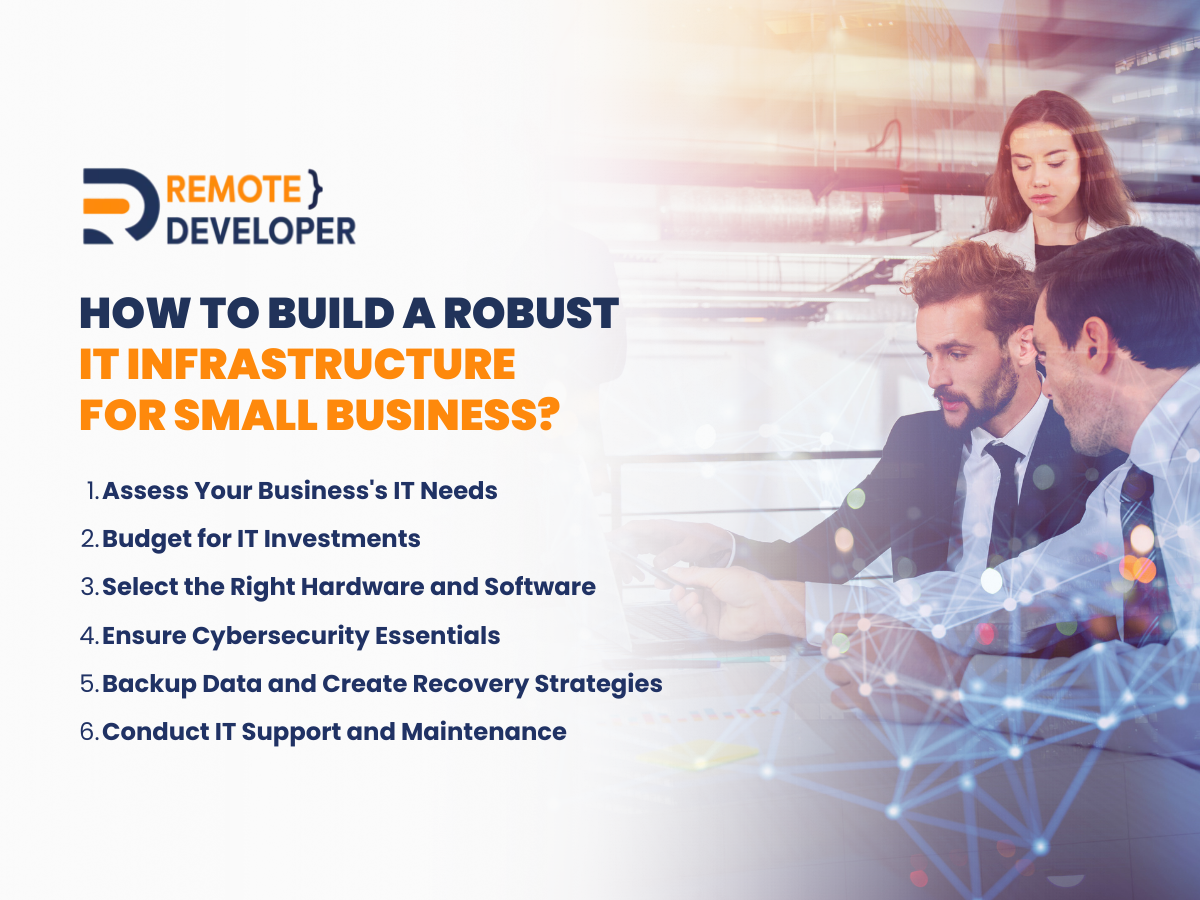Let us face it, information technology (IT) infrastructure for small businesses can be a tangled mess if you do not do it right the first time. Moreso, if you committed mistakes you are not even aware of. Sadly, that blow will be even more sore if you hired an IT agency before but also made those faux pas.
If your dream is to have streamlined operations, laser-sharp security, and happy, productive employees, then are in the right place, dear reader.
Here, we are sharing a practical guide that cuts through the tech jargon and reveals straightforward steps to building a secure IT framework, and the IT infrastructure requirements you need to check off one by one.
So, read on to find out how you can create a fortress-like IT foundation that fuels your business growth—not slow it down.
What is an IT infrastructure?
Before we get to the core of this article, understanding the IT infrastructure setup meaning is crucial.
The best way to describe the SMB IT infrastructure is the foundation of a home.
In a home, you have the brick and mortar that form the skeleton that holds up a house. Much like that analogy, the IT infrastructure for small businesses is the invisible backbone that enables everything from email and file sharing to customer relationship management and online sales.
Why do small business needs an IT infrastructure?
Today, agility is everything. This rings even more true for startups since everything in the digital space is so fast-paced.
Think of it this way: Your business is on a life raft. The digital space and your market are the treacherous waters that you must journey through.
If your boat is not sturdy then it is a recipe for disaster, the same applies to the IT infrastructure for small businesses. Of course, if you build it to be sturdy but stiff, it will still have problems.
So, you must weave in scalable technology for startups, then it is not just a life raft anymore. Because your IT infrastructure is sturdy and flexible, it is capable of adapting to your business’s growing needs.
What makes a good IT Infrastructure?
There are a lot of things that go into building the IT infrastructure for small businesses. As mentioned earlier, it needs to be sturdy to be long-lasting and it needs to be flexible so it can adapt to the scale of your business’s growth.
Here is a small business IT infrastructure checklist that you can follow and check off as you build yours.
- Reliable Computers
- Robust Network Backbone
- Secure Servers
- Stable and Secure Operating System
- Cloud-Based Business Applications
- Comprehensive Security Protection
- Cloud Computing and Storage
- Data Backup and Recovery Plan
- Secure Wi-Fi Network
- Strong Password Management
- Consistent Employee Training
- Regular Software Updates
- Hardware Maintenance
- Comprehensive IT Support
How to build a robust IT infrastructure for small business?
There are so many IT infrastructures for small businesses examples available on the Internet. While these may help serve as a guide that will provide you with a better idea, keep in mind these are tailor-fit for the business that built it.
With that in mind, we put together an easy step-by-step that will enable you to do the same.
Assess Your Business’s IT Needs
Building an IT infrastructure for small businesses requires you to assess what you have right now and what you will need. So, for this step, you should answer the following questions:
- What IT issues slow you down or frustrate employees?
- Are there security concerns or software limitations?
- Where do you see your business in the next few years?
- Will your IT needs change as you grow?
- How tech-savvy are your employees?
- What software and devices do they need to be productive?
The aim is to get a good sense of your short-term and long-term needs since this investment will yield great results if you do it right from the beginning.

Budget for IT Investments
Moreover, once you have figured out your specific IT needs then it is a lot easier to take stock of your financial resources. For this step, you need to figure out what essentials you need to prioritise.
Even if it is a small office IT setup, there are things you will need first before the rest follows. So, here is how we suggest you do it:
- Identify your critical IT needs first with a needs assessment.
- Divide your IT needs into essential, important, and optional categories.
- Window shop around first for solutions that fit your budget and needs before you commit.
- Explore subscription-based software as an alternative to expensive upfront purchases.
- Account for ongoing maintenance, software updates, and potential support needs when budgeting.
- Evaluate the ROI (return on investment) of each upgrade and prioritize those that offer significant performance or security improvements.
- Regularly review your IT budget and infrastructure to ensure it aligns with your evolving needs.
Select the Right Hardware and Software
Choosing the right balance of power and affordability for hardware and software can be tricky since there are so many options available on the Internet. Of course, building your small business IT setup adds a layer of that challenge.
So, before you go out window shopping, here are a few things to keep in mind.
- Go back to your list of needs and consider how you will use each hardware and software.
- Focus on reliable hardware like workstations and secure servers before considering fancy gadgets.
- Compare features, pricing models, and user reviews of different hardware and software providers.
- Consider cloud-based storage, applications, and infrastructure instead of on-premise solutions.
- If you are not that well-versed, then consult with an IT expert to analyze your needs and recommend suitable hardware and software solutions.
Ensure Cybersecurity Essentials
One of the steps you need to pay close attention to is the security of the IT infrastructure for small businesses. We have seen on the news how even the industry giants are crippled by cyber threats.
So, when building your small business tech setup, you should already be thinking of how you can create a robust defence. Of course, most, if not all, businesses have checked off the following items to bolster their cybersecurity:
- Install a firewall
- Secure your Wi-Fi
- Educate all employees about good practices for cybersecurity.
- Regularly conduct software updates
- Invest in high-quality antivirus and anti-malware
- Always monitor your network
Backup Data and Create Recovery Strategies
Data is the currency of today’s digital age. So, if your defence is weak, then you are essentially inviting everyone to steal your hoard.
Moreover, data breaches are also quite costly. Every minute your system is down, you are essentially bleeding money.
With that in mind, here are a few things you need to do when you create your backup data and recovery plan.
- Go for a combination of local hard drives, network-attached storage (NAS), and secure cloud services like Google Drive or Dropbox.
- Back up everything, daily for critical data, less frequently for less crucial information.
- Create a clear-cut process in case of data loss, such as who to contact, which backups to use, and how to restore data.
- Conduct recovery tests frequently to make sure they work.
- Lock your data with encryption to add an extra layer of protection to your data.
Conduct IT Support and Maintenance
Lastly, a robust IT infrastructure will not flourish and function well if you do not do regular maintenance and strategic “pruning” to keep it thriving.
With that said, here is an easy guide that details how to do it:
- Set up automated tools to monitor network health, performance metrics, and security threats.
- Prioritize installing security patches and software updates as soon as they become available.
- Schedule regular hardware checks for dust build-up, overheating issues, and potential component failures.
- Educate your employees on basic IT hygiene practices like strong passwords, phishing awareness, and proper data handling.
- Test your data backup and recovery systems regularly to ensure they function flawlessly.
We also encourage you to consult and partner with a managed service provider (MSP). They will help in handling the time-consuming portion of maintaining your IT infrastructure.
Conclusion
Now, you have a better idea of what goes into creating a robust IT infrastructure for small businesses.
But this is not the finish line. This is just the launchpad. With your IT foundation firmly built and in place, you are now poised to conquer new markets, unleash employee creativity, and scale your business to uncharted heights.
For expert guidance on building a strong IT infrastructure tailored to your small business, contact us!

